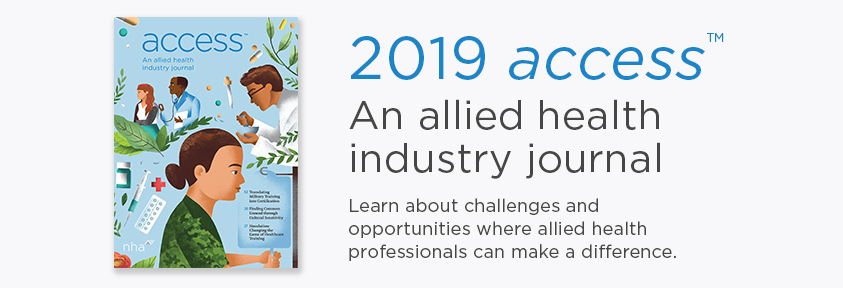Struggling to Help Stressed Allied Health Students Succeed Academically? Make Time for Mental Health.
The 2020 Spring semester has been a time of unprecedented stress for allied health professionals, students, and instructors. An April 2020 survey conducted by Inside Higher Ed in partnership with Hanover Research demonstrated that about 91% of leaders in higher education are worried about the mental and physical health of their students.
Fear and anxiety make formidable foes against concentration, so what can you do as an instructor to reduce students’ stress?
Making mental health a top priority for stressed allied health students may be just what they need right now to succeed academically.
Two free, easy mental health resources that allied health students can access at any time are mindfulness and meditation. Several research studies have proven that meditation’s myriad mental and physical health benefits include:
- Improved emotional health
- Enhanced self-awareness
- Better sleep
- Increased focus and discipline
- Greater ability to empathize with others
- Better memory and a clearer mind
This list of perks is perfect for any student at any time but are especially useful for those who find it difficult to focus on school in the face of a global health crisis.
Are allied health educators capable of teaching basic meditation to students?
In a word, yes! Of course, before getting started, you’ll need to learn the basics, yourself. While mindfulness and meditation are often conflated, they’re actually two separate practices that can work hand in hand to support student success:
Mindfulness is the simple, but powerful, act of paying close attention to an activity, your surroundings, or an object. It involves leveraging all five senses to notice and ground yourself in a moment.
Meditation is an intentional practice that involves turning your focus inward with the goal of increasing calmness, improving concentration, and achieving emotional balance. In meditation, it’s ok and even encouraged to allow the mind to wander. Sometimes, people fall asleep during an intense meditation session, and that’s ok, too. (Unless, of course, that meditation session falls smack in the middle of class.)
There are a ton of ways to practice both mindfulness and meditation, from body scans, to mantras, breathing exercises, and more! Don’t be intimidated by this. Instead, view it as an opportunity to experiment and find what works best to support your allied health students’ mental health.
Tips to implement mindfulness and meditation in higher education:
Be intentional.
Choose a time that you feel a little more calm and mental clarity would be particularly beneficial to your allied health students. For example, it might be helpful to play a guided meditation at the beginning or end of each class. Another idea is to lead the students in a calming deep breathing or body scan exercise before an important exam.
When your students seem particularly overwhelmed, consider introducing a mantra that can calm them in the moment - even later when you’re not around. Deciding on a mantra doesn’t have to be complicated. It can be a positive affirmation, a reminder of the student’s goals, or just something optimistic to focus on. Something as simple as, “I am capable.” or “This, too, shall pass.” can calm students and re-center their mindset.
Take Advantage of Available Resources
Free apps for meditation and mindfulness are available to both allied health teachers and stressed out college students. Here are a few we suggest:
Insight Timer features over 40,000 FREE meditations.
Smiling Mind was developed by educators and psychologists. It’s something your students’ may find useful for their entire families.
Calm Schools Initiative is a free version of the Calm app for teachers. Although it’s marketed to grade school and secondary school teachers, allied health instructors can adapt the ideas presented to be applicable for their students.
Calm and Headspace are both reputable pay-to-use apps that you might find worth the investment.
You can also play this 5-5-5 breathing exercise by Julie Stoetzer, NHA product marketing manager and certified meditation instructor, over Zoom to engage students in mindfulness during distance learning.

Encourage your allied health students to use mindfulness and meditate outside of class.
With so much to worry about, students might give you some pushback about learning how to meditate or practice mindfulness. Remind them that this skillset will serve them well long beyond graduation, when they face stress and burnout in allied health careers.
Here are some skills instructors can encourage their students to master to reduce stress and improve mental health:
Deep Breathing
Deep breaths increase oxygen to the brain, slowing the mind & heart rate. This alone helps alleviate stress by leaps and bounds. Teach your students to take a deep breath before settling in to work on any assignment, especially ones they feel anxious about.
Single-Tasking
Multi-tasking is tempting for allied health students with a multitude of responsibilities- both in their academics and personal lives. However, research shows that it’s not so great for productivity and retaining information. To be the most efficient and effective in their work, students can prioritize tasks in a list, then focus their full attention on one thing at a time until the job is done.
Visualization
Famous actors, sports stars, and CEOs have long touted the contributions of visualization to their success. Mindfulness exercises that involve visualizing a particular outcome can lessen feelings of self-doubt and fear. They also increase confidence and motivation. You can encourage your students to take a moment at the start of each day to see themselves achieving a personal goal. For example, they might imagine what it would look like and feel like to ace their next test, or finally finish that paper they’re procrastinating on.
Set them Up for Success
You can’t force your allied health students to participate in these practices outside of class, but you can make sure that the resources to do so are available to them at home. Consider including the quick and easy handout on 10 steps to mindfulness meditation (button below) in your syllabus to guide them through the basics of simple, stress-relieving meditation exercises on their own whenever they’re ready to try.
As an allied health educator, you strive to see your students succeed both inside and outside of the academic setting. We hope that taking these simple steps to make mindfulness and meditation accessible to your students will be a stress reliever for you, as much as it is to them. By incorporating genuine concern for students’ mental health into your curriculum in this way, you can rest assured that you’re supporting their personal and career success during the COVID-19 pandemic and beyond.





